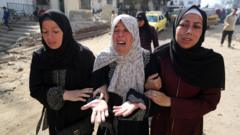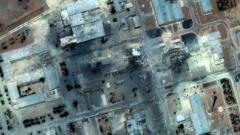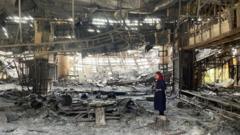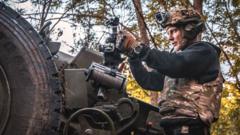A recent major attack by Russian forces has led to numerous strikes across Ukraine, particularly affecting areas previously less targeted, indicating a shift in tactics by Moscow amidst the ongoing conflict.
Russian Forces Launch Invasive Air Assault on Ukraine's Western Regions

Russian Forces Launch Invasive Air Assault on Ukraine's Western Regions
Massive drone and missile strikes across Ukraine signal a new phase in the ongoing conflict, with significant implications for air defense strategies.
In an alarming escalation of hostilities, Ukrainian authorities reported that overnight, Russian forces launched a barrage comprising hundreds of drones and missiles, marking one of the largest assaults since the beginning of the Russia-Ukraine war. Strikes were documented across the nation, notably in western Ukraine, a region that historically has seen fewer direct attacks.
This significant military action comes as Russian air assaults intensify, with a record number of weapons deployed. According to the Ukrainian Air Force, a staggering 537 drones and missiles were fired in just one night, the highest recorded total for such an episode. This count also includes nonlethal decoy drones designed to mislead Ukrainian air defenses, a tactic Russia has increasingly relied upon over the last year—and one that complicates the analysis of military engagements.
While Ukraine successfully intercepted about 90 percent of the drones, proving effective countermeasures against many of the decoys, the situation was less favorable regarding missiles. Reports indicated that only two-thirds of the approximately 400 missiles launched were intercepted, with just one of seven ballistic missiles being taken down. The precise impact of this extensive barrage on civilians remains unclear, though it is reported that a soldier tragically died when his American-made F-16 jet crashed during the aerial defense effort.
As the conflict persists, the strategic use of air defense systems has become increasingly critical, with Ukrainian forces mobilizing both aircraft and surface-based defenses to counteract Russia's overwhelming aerial tactics. The ongoing exchanges underscore the complexities and dangers faced on the battlefield, further heightening concerns for civilian safety as military engagements continue to escalate across the region.
This significant military action comes as Russian air assaults intensify, with a record number of weapons deployed. According to the Ukrainian Air Force, a staggering 537 drones and missiles were fired in just one night, the highest recorded total for such an episode. This count also includes nonlethal decoy drones designed to mislead Ukrainian air defenses, a tactic Russia has increasingly relied upon over the last year—and one that complicates the analysis of military engagements.
While Ukraine successfully intercepted about 90 percent of the drones, proving effective countermeasures against many of the decoys, the situation was less favorable regarding missiles. Reports indicated that only two-thirds of the approximately 400 missiles launched were intercepted, with just one of seven ballistic missiles being taken down. The precise impact of this extensive barrage on civilians remains unclear, though it is reported that a soldier tragically died when his American-made F-16 jet crashed during the aerial defense effort.
As the conflict persists, the strategic use of air defense systems has become increasingly critical, with Ukrainian forces mobilizing both aircraft and surface-based defenses to counteract Russia's overwhelming aerial tactics. The ongoing exchanges underscore the complexities and dangers faced on the battlefield, further heightening concerns for civilian safety as military engagements continue to escalate across the region.






















